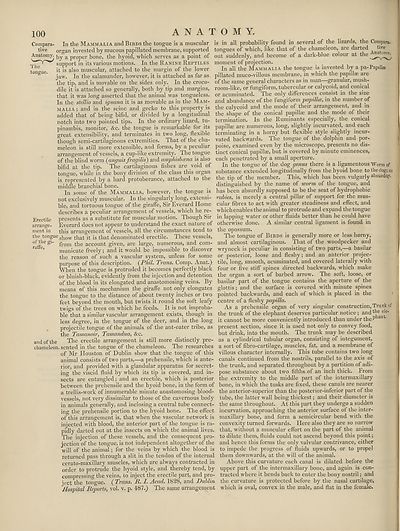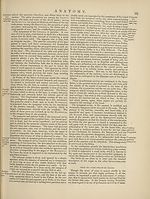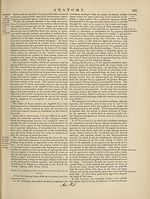Encyclopaedia Britannica > Volume 3, Anatomy-Astronomy
(108) Page 100
Download files
Complete book:
Individual page:
Thumbnail gallery: Grid view | List view

100
ANATOMY.
Compara. In the Mammalia and Birds the tongue is a muscular
live organ invested by mucous papillated membrane, supported - Anatomv
Anatomy, a pr0per bone, the hyoid, which serves as a point of out suddenly, and become of a dark-blue colour at the
support in its various motions. In the Ranine Reptiles moment of projection
is in all probability found in several of the lizards, the Compara.
tongues of which, like that of the chameleon, are darted hve
Erectile
arrange¬
ment in
raffe.
it is also muscular, attached to the margin of the lower
jaw. In the salamander, however, it is attached as far as
the tip, and is movable on the sides only. In the croco¬
dile it is attached so generally, both by tip and margins,
that it was long asserted that the animal was tongueless.
In the stellio and iguana it is as movable as in the Mam¬
malia ; and in the seine and gecko to this property is
added that of being bifid, or divided by a longitudinal
notch into two pointed tips. In the ordinary lizard, tu-
pinambis, monitor, &c. the tongue is remarkable for its
great extensibility, and terminates in two long, flexible
though semi-cartilaginous extremities. That of the cha¬
meleon is still more extensible, and forms, by a peculiar
arrangement of vessels, a cup-like extremity. The tongue
of the blind worm (anguis fragilis) and amphisb&na is also
bifid at the tip. The cartilaginous fishes are void of
tongue, while in the bony division of the class this organ
is represented by a hard protuberance, attached to the
middle branchial bone.
In some of the Mammalia, however, the tongue is
not exclusively muscular. In the singularly long, extensi¬
ble, and tortuous tongue of the giraffe, Sir Everard Home
describes a peculiar arrangement of vessels, which he re¬
presents as a substitute for muscular motion. Though Sir
Everard does not appear to understand the exact nature of
this arrangement of vessels, all the circumstances tend to
the tongue S|10W tiiat it js that denominated erectile. These vessels,
ot the gi- from tjie account given, are large, numerous, and com¬
municate freely; and it would be impossible to discover
the reason of such a vascular system, unless for some
purpose of this description. (Phil. Trans. Comp. Anat.)
When the tongue is protruded it becomes perfectly black
or bluish-black, evidently from the injection and detention
of the blood in its elongated and anastomosing veins. By
means of this mechanism the giraffe not only elongates
the tongue to the distance of about twenty inches or two
feet beyond the mouth, but twists it round the soft leafy
twigs of the trees on which he feeds. It is not improba¬
ble that a similar vascular arrangement exists, though in
less degree, in the tongue of the deer, and in the long
projectile tongue of the animals of the ant-eater tribe, as
the Tamanoir, Tamandua, &c.
The erectile arrangement is still more distinctly pre¬
chameleon. sented in the tongue of the chameleon. The researches
of Mr Houston of Dublin show that the tongue of this
animal consists of two parts,—a prehensile, which is ante¬
rior, and provided with a glandular apparatus for secret¬
ing the viscid fluid by which its tip is covered, and in¬
sects are entangled; and an erectile, which is posterior
between the prehensile and the hyoid bone, in the form of
a trellis-work of innumerable minute anastomosing blood¬
vessels, not very dissimilar to those of the cavernous body
in animals generally, and inclosing a central tube connect¬
ing the prehensile portion to the hyoid bone. The effect
of this arrangement is, that when the vascular network is
injected with blood, the anterior part of the tongue is ra¬
pidly darted out at the insects on which the animal lives.
The injection of these vessels, and the consequent pro¬
jection of the tongue, is not independent altogether of the
will of the animal; for the veins by which the blood is
returned pass through a slit in the tendon of the internal
cerato-maxillary muscles, which are always contracted in
order to protrude the hyoid style, and thereby tend, by
compressing the veins, to inject the erectile part, and pro¬
ject the tongue. (Trans. R. I. Acad. 1828, and Dublin
'Hospital Reports, vol. v. p. 487.) The same arrangement
and of the
In all the Mammalia the tongue is invested by a pa-Papillae
pillated muco-villous membrane, in which the papillae are
of the same general characters as in man—granular, mush¬
room-like, or fungiform, tubercular or calycoid, and conical
or acuminated. The only differences consist in the size
and abundance of the fungiform papillae, in the number of
the calycoid and the mode of their arrangement, and in
the shape of the conical papillae and the mode of their
termination. In the Ruminants especially, the conical
papillae are numerous, long, slightly incurvated, and each
terminating in a horny but flexible style slightly incur¬
vated backwards. The tongue of the dolphin and por¬
poise, examined even by the microscope, presents no dis¬
tinct conical papillae, but is covered by minute eminences,
each penetrated by a small aperture.
In the tongue of the dog genus there is a ligamentous Worm of
substance extended longitudinally from the hyoid bone to the dog; ns
the tip of the member. This, which has been vulgarly absurdity-
distinguished by the name of worm of the tongue, and
has been absurdly supposed to be the seat of hydrophobic
rabies, is merely a central pillar of support for the mus¬
cular fibres to act with greater steadiness and effect, and
which enables the animal to protrude and expand the tongue
in lapping water or other fluids better than he could have
otherwise done. A similar central ligament is found in
the opossum.
The tongue of Birds is generally more or less homy,
and almost cartilaginous. That of the woodpecker and
wryneck is peculiar in consisting of two parts,—a basilar
or posterior, loose and fleshy; and an anterior projec¬
tile, long, smooth, acuminated, and covered laterally with
four or five stiff spines directed backwards, which make
the organ a sort of barbed arrow. The soft, loose, or
basilar part of the tongue contains the aperture of the
glottis; and the surface is covered with minute spines
pointed backwards, and each of which is placed in the
centre of a fleshy papilla.
As a prehensile organ of very singular construction, Trunk of
the trunk of the elephant deserves particular notice; and ^ e)e*
it cannot be more conveniently introduced than under the P an '
present section, since it is used not only to convey food,
but drink, into the mouth. The trunk may be described
as a cylindrical tubular organ, consisting of integument,
a sort of fibro-cartilage, muscles, fat, and a membrane of
villous character internally. This tube contains two long
canals continued from the nostrils, parallel to the axis of
the trunk, and separated throughout by a partition of adi¬
pose substance about two fifths of an inch thick. From
the extremity to the middle part of the intermaxillary
bone, in which the tusks are fixed, these canals are nearer
the anterior-superior than the posterior-inferior part of the
tube, the latter wall being thickest; and their diameter is
the same throughout. At this part they undergo a sudden
incurvation, approaching the anterior surface of the inter¬
maxillary bone, and form a semicircular bend with the
convexity turned forwards. Here also they are so narrow
that, without a muscular effort on the part of the animal
to dilate them, fluids could not ascend beyond this point;
and hence this forms the only valvular contrivance, either
to impede the progress of fluids upwards, or to propel
them downwards, at the will of the animal.
Above this curvature each canal is dilated before the
upper part of the intermaxillary bone, and again is con¬
tracted where it bends back to enter the bony nostril; and
the curvature is protected before by the nasal cartilage,
which is oval, convex in the male, and flat in the female.
ANATOMY.
Compara. In the Mammalia and Birds the tongue is a muscular
live organ invested by mucous papillated membrane, supported - Anatomv
Anatomy, a pr0per bone, the hyoid, which serves as a point of out suddenly, and become of a dark-blue colour at the
support in its various motions. In the Ranine Reptiles moment of projection
is in all probability found in several of the lizards, the Compara.
tongues of which, like that of the chameleon, are darted hve
Erectile
arrange¬
ment in
raffe.
it is also muscular, attached to the margin of the lower
jaw. In the salamander, however, it is attached as far as
the tip, and is movable on the sides only. In the croco¬
dile it is attached so generally, both by tip and margins,
that it was long asserted that the animal was tongueless.
In the stellio and iguana it is as movable as in the Mam¬
malia ; and in the seine and gecko to this property is
added that of being bifid, or divided by a longitudinal
notch into two pointed tips. In the ordinary lizard, tu-
pinambis, monitor, &c. the tongue is remarkable for its
great extensibility, and terminates in two long, flexible
though semi-cartilaginous extremities. That of the cha¬
meleon is still more extensible, and forms, by a peculiar
arrangement of vessels, a cup-like extremity. The tongue
of the blind worm (anguis fragilis) and amphisb&na is also
bifid at the tip. The cartilaginous fishes are void of
tongue, while in the bony division of the class this organ
is represented by a hard protuberance, attached to the
middle branchial bone.
In some of the Mammalia, however, the tongue is
not exclusively muscular. In the singularly long, extensi¬
ble, and tortuous tongue of the giraffe, Sir Everard Home
describes a peculiar arrangement of vessels, which he re¬
presents as a substitute for muscular motion. Though Sir
Everard does not appear to understand the exact nature of
this arrangement of vessels, all the circumstances tend to
the tongue S|10W tiiat it js that denominated erectile. These vessels,
ot the gi- from tjie account given, are large, numerous, and com¬
municate freely; and it would be impossible to discover
the reason of such a vascular system, unless for some
purpose of this description. (Phil. Trans. Comp. Anat.)
When the tongue is protruded it becomes perfectly black
or bluish-black, evidently from the injection and detention
of the blood in its elongated and anastomosing veins. By
means of this mechanism the giraffe not only elongates
the tongue to the distance of about twenty inches or two
feet beyond the mouth, but twists it round the soft leafy
twigs of the trees on which he feeds. It is not improba¬
ble that a similar vascular arrangement exists, though in
less degree, in the tongue of the deer, and in the long
projectile tongue of the animals of the ant-eater tribe, as
the Tamanoir, Tamandua, &c.
The erectile arrangement is still more distinctly pre¬
chameleon. sented in the tongue of the chameleon. The researches
of Mr Houston of Dublin show that the tongue of this
animal consists of two parts,—a prehensile, which is ante¬
rior, and provided with a glandular apparatus for secret¬
ing the viscid fluid by which its tip is covered, and in¬
sects are entangled; and an erectile, which is posterior
between the prehensile and the hyoid bone, in the form of
a trellis-work of innumerable minute anastomosing blood¬
vessels, not very dissimilar to those of the cavernous body
in animals generally, and inclosing a central tube connect¬
ing the prehensile portion to the hyoid bone. The effect
of this arrangement is, that when the vascular network is
injected with blood, the anterior part of the tongue is ra¬
pidly darted out at the insects on which the animal lives.
The injection of these vessels, and the consequent pro¬
jection of the tongue, is not independent altogether of the
will of the animal; for the veins by which the blood is
returned pass through a slit in the tendon of the internal
cerato-maxillary muscles, which are always contracted in
order to protrude the hyoid style, and thereby tend, by
compressing the veins, to inject the erectile part, and pro¬
ject the tongue. (Trans. R. I. Acad. 1828, and Dublin
'Hospital Reports, vol. v. p. 487.) The same arrangement
and of the
In all the Mammalia the tongue is invested by a pa-Papillae
pillated muco-villous membrane, in which the papillae are
of the same general characters as in man—granular, mush¬
room-like, or fungiform, tubercular or calycoid, and conical
or acuminated. The only differences consist in the size
and abundance of the fungiform papillae, in the number of
the calycoid and the mode of their arrangement, and in
the shape of the conical papillae and the mode of their
termination. In the Ruminants especially, the conical
papillae are numerous, long, slightly incurvated, and each
terminating in a horny but flexible style slightly incur¬
vated backwards. The tongue of the dolphin and por¬
poise, examined even by the microscope, presents no dis¬
tinct conical papillae, but is covered by minute eminences,
each penetrated by a small aperture.
In the tongue of the dog genus there is a ligamentous Worm of
substance extended longitudinally from the hyoid bone to the dog; ns
the tip of the member. This, which has been vulgarly absurdity-
distinguished by the name of worm of the tongue, and
has been absurdly supposed to be the seat of hydrophobic
rabies, is merely a central pillar of support for the mus¬
cular fibres to act with greater steadiness and effect, and
which enables the animal to protrude and expand the tongue
in lapping water or other fluids better than he could have
otherwise done. A similar central ligament is found in
the opossum.
The tongue of Birds is generally more or less homy,
and almost cartilaginous. That of the woodpecker and
wryneck is peculiar in consisting of two parts,—a basilar
or posterior, loose and fleshy; and an anterior projec¬
tile, long, smooth, acuminated, and covered laterally with
four or five stiff spines directed backwards, which make
the organ a sort of barbed arrow. The soft, loose, or
basilar part of the tongue contains the aperture of the
glottis; and the surface is covered with minute spines
pointed backwards, and each of which is placed in the
centre of a fleshy papilla.
As a prehensile organ of very singular construction, Trunk of
the trunk of the elephant deserves particular notice; and ^ e)e*
it cannot be more conveniently introduced than under the P an '
present section, since it is used not only to convey food,
but drink, into the mouth. The trunk may be described
as a cylindrical tubular organ, consisting of integument,
a sort of fibro-cartilage, muscles, fat, and a membrane of
villous character internally. This tube contains two long
canals continued from the nostrils, parallel to the axis of
the trunk, and separated throughout by a partition of adi¬
pose substance about two fifths of an inch thick. From
the extremity to the middle part of the intermaxillary
bone, in which the tusks are fixed, these canals are nearer
the anterior-superior than the posterior-inferior part of the
tube, the latter wall being thickest; and their diameter is
the same throughout. At this part they undergo a sudden
incurvation, approaching the anterior surface of the inter¬
maxillary bone, and form a semicircular bend with the
convexity turned forwards. Here also they are so narrow
that, without a muscular effort on the part of the animal
to dilate them, fluids could not ascend beyond this point;
and hence this forms the only valvular contrivance, either
to impede the progress of fluids upwards, or to propel
them downwards, at the will of the animal.
Above this curvature each canal is dilated before the
upper part of the intermaxillary bone, and again is con¬
tracted where it bends back to enter the bony nostril; and
the curvature is protected before by the nasal cartilage,
which is oval, convex in the male, and flat in the female.
Set display mode to:
![]() Universal Viewer |
Universal Viewer | ![]() Mirador |
Large image | Transcription
Mirador |
Large image | Transcription
Images and transcriptions on this page, including medium image downloads, may be used under the Creative Commons Attribution 4.0 International Licence unless otherwise stated. ![]()
| Encyclopaedia Britannica > Encyclopaedia Britannica > Volume 3, Anatomy-Astronomy > (108) Page 100 |
|---|
| Permanent URL | https://digital.nls.uk/193758752 |
|---|
| Attribution and copyright: |
|
|---|---|
| Shelfmark | EB.16 |
|---|---|
| Description | Ten editions of 'Encyclopaedia Britannica', issued from 1768-1903, in 231 volumes. Originally issued in 100 weekly parts (3 volumes) between 1768 and 1771 by publishers: Colin Macfarquhar and Andrew Bell (Edinburgh); editor: William Smellie: engraver: Andrew Bell. Expanded editions in the 19th century featured more volumes and contributions from leading experts in their fields. Managed and published in Edinburgh up to the 9th edition (25 volumes, from 1875-1889); the 10th edition (1902-1903) re-issued the 9th edition, with 11 supplementary volumes. |
|---|---|
| Additional NLS resources: |
|

